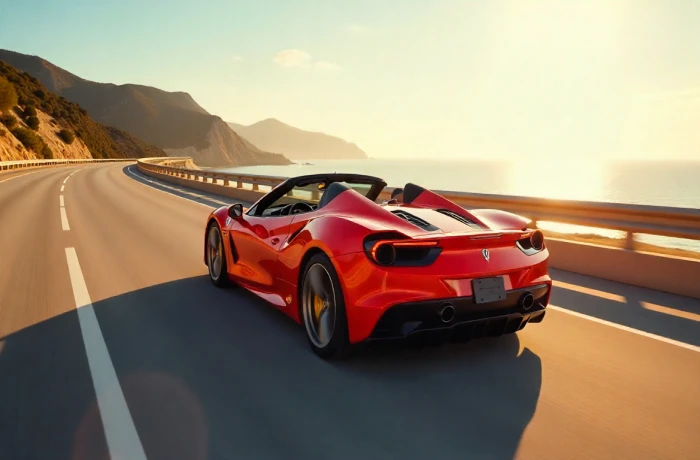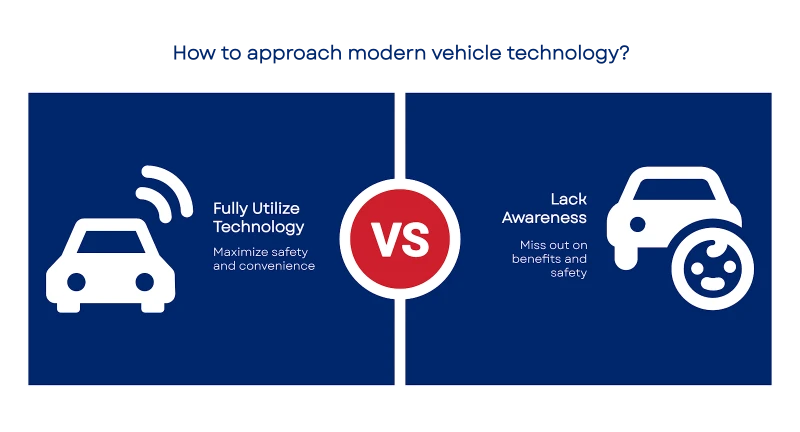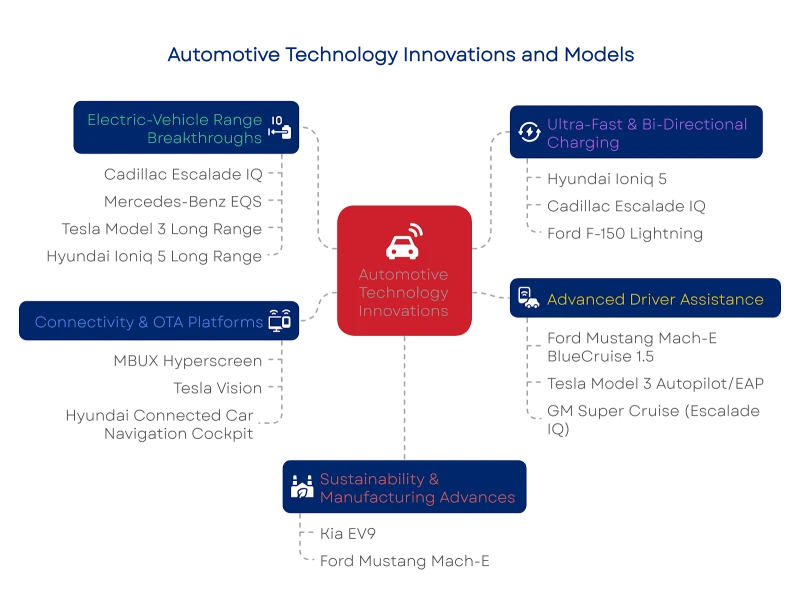Some 2020s vehicles can drive in highway traffic with no hands on the wheel, park without help, and deliver live traffic updates while you sit in the driver’s seat. These features are active today—not part of a future concept.
Modern vehicles are being built with systems that assist with speed control, lane keeping, and hazard response. AI is managing tasks that used to require full attention. The role of the driver is changing.
Still, many people don’t take advantage of the full capabilities built into their cars.. Others are purchasing new vehicles that lack the latest functions, without realizing what’s available.
What You’ll Learn
In the sections ahead, you’ll learn:
Which Innovations Define 2020s Cars
How These Systems Affect the Way People Drive and Shop
What To Check If You're Buying or Upgrading
Summary
The 2020s ushered in a wave of transformative car technologies, including ultra-efficient batteries, near-autonomous driver-assistance systems, and vehicle-to-everything connectivity, as well as sustainable manufacturing practices. Below is an expanded list of concrete production and near-production models (all on sale or announced for the U.S. market by mid-2025) that embody each of these breakthroughs.
Electric-Vehicle (EV) Range Breakthroughs
Ultra-Fast & Bi-Directional Charging
Advanced Driver Assistance ( Level 2 / 2+ )
Connectivity & Over-the-Air (OTA) Platforms
MBUX Hyperscreen in the Mercedes EQS features three displays behind a single 56-inch glass pane, with complete OTA feature upgrades.
Tesla Vision and unified software stack enabling quarterly feature drops on every Model 3 build.
The Hyundai Connected Car Navigation Cockpit (Ioniq 5 facelift) features OTA powertrain logic and integrated payment.
Sustainability & Manufacturing Advances
Innovation-to-Model Matrix
Why These Models Matter
Scalability: Each vehicle showcases technology slated to cascade into mass-volume segments by 2030, e.g., GM’s Ultium pack in the Trax EV.
Infrastructure Pull-Through: 350 kW charging on the Ioniq 5 and Escalade IQ accelerates high-power station deployments.
Regulatory Impact: Level 2+ suites (BlueCruise, Super Cruise) are hastening U.S. policy on driver-monitoring standards.
Expect 2026–2027 launches, such as Toyota’s first solid-state battery sedan and Honda’s Level 3 Acura flagship, which will push the range near 500 miles and feature hands-free capability on urban arterials. The 2020s models above are the bridge: tangible proof that yesterday’s concept tech is now driveway reality.
In short, the “models” are available in showrooms today, from Cadillac’s 9,000-lb, 460-mile Escalade IQ to Hyundai’s 18-minute-charge Ioni5, all rolling testbeds for the next mobility era.
What Has Changed Since the Last Decade
Reflect on what smartphones looked like in 2009. Now imagine trying to use one of those today. Driving a car built in the early 2010s can feel the same. Many of these models lack modern safety features, connected capabilities, and software-based performance enhancements.
Since 2010, vehicles have shifted from mechanical systems to software-managed platforms. Real-time navigation, partial automation, and remote updates are now standard in many models. Some cars adjust settings based on road conditions. Others learn driving patterns or add new features through software.
The EV Revolution: Long-Range Electric Cars Are Here
Electric vehicles in the 2020s are reaching ranges that meet the needs of both short commutes and long road trips. This is the result of improved battery design, better energy management systems, and broader access to charging infrastructure.
Cadillac Escalade IQ
The Cadillac Escalade IQ represents one of the most advanced electric SUVs released so far in the 2020s. It’s built on GM’s Ultium platform and is powered by a 205-kilowatt-hour battery. This setup supports an estimated 460 miles of range, making it one of the longest-range electric vehicles available today.
This model targets drivers who want the size and features of a traditional Escalade, but with an all-electric powertrain. The transition to battery-electric does not remove comfort, cargo space, or performance. The Escalade IQ delivers strong torque, quick acceleration, and a smooth ride with a quiet cabin.
Key features include:
Battery and Performance: Uses GM’s Ultium technology with a 205 kWh pack. Power output is designed to match or exceed gas-powered versions. The platform supports quick acceleration and efficient highway driving.
Charging Capabilities: Accepts 350 kW DC fast charging. Under ideal conditions, it can add up to 100 miles of range in around 10 minutes. This supports high-mileage travel with shorter charging stops.
Driver Assistance and Connectivity: Equipped with GM’s Super Cruise system. This allows for hands-free driving on compatible highways. Also includes large digital displays, real-time system updates, and over-the-air (OTA) software support.
Interior and Materials: Designed for comfort with high-quality finishes, multiple seating configurations, and upgraded infotainment. The flat-floor layout adds interior flexibility.
The Escalade IQ combines traditional SUV practicality with modern electric performance. It’s built for long-distance travel, family use, and drivers who want both comfort and range without relying on gasoline.
Mercedes-Benz EQS: Electric Range With Flagship Refinement
The Mercedes-Benz EQS is the brand’s leading electric sedan. It delivers an estimated range of up to 390 miles using a 118-kilowatt-hour battery. Built on a dedicated EV platform, the EQS combines long-distance capability with comfort, efficiency, and advanced software features.
Mercedes designed this model for quiet operation and smooth handling. Its low-drag body helps extend highway range, and its cabin was built to minimize road noise. The EQS targets drivers who want an electric powertrain without giving up the feel of a full-size luxury vehicle.
Key features include:
Battery and Efficiency: Powered by a 118 kWh battery system. The vehicle’s design minimizes drag and maximizes energy efficiency, allowing the car to travel farther without requiring a larger battery.
Charging Capabilities: Supports DC fast charging up to 200 kilowatts. Under proper conditions, the battery can gain around 186 miles of range in about 15 minutes.
Interior Technology: This includes the MBUX Hyperscreen, a wide-format digital display that seamlessly blends three screens into one. The system supports navigation, voice commands, and remote updates through cloud-based software.
Driver Assistance: Comes with adaptive cruise control, traffic-aware lane keeping, and automatic parking. Some models also support route planning that takes into account battery status and public charging availability.
Interior and Ride Quality: The EQS utilizes soft materials and advanced sound insulation to minimize interior noise. Rear-wheel steering enhances maneuverability in tight spaces. Its flat-floor platform gives added legroom and cabin flexibility.
The EQS is designed for drivers who want long range, quiet driving, and up-to-date software tools in a single package. It shows how electric platforms are being used for more than just emissions reduction.
Tesla Model 3 Long Range
The Tesla Model 3 Long Range is one of the most widely used electric vehicles in the U.S. It offers an estimated 363 miles of range from an 82-kilowatt-hour battery. Built for both daily use and long trips, this model combines efficient power management with real-time software support and access to Tesla’s charging network.
The Model 3 emphasizes simple design and quick performance. It also stands out for its ability to receive software updates that change how the car functions over time. Owners can gain new features without needing to visit a service center.
Key features include:
Battery and Efficiency: Powered by an 82 kWh battery. The Model 3 uses energy-dense cells and efficient motor tuning to deliver a high range relative to battery size. It supports both city and highway driving without frequent charging.
Charging Capabilities: Compatible with Tesla Superchargers and standard CCS fast charging. Superchargers can provide up to 175 miles of range in about 15 minutes. Charger availability is integrated into the car’s trip planner.
Software and Updates: Runs on Tesla’s custom software stack. The system includes navigation, entertainment, and driving controls, and can be updated over the air. Updates may include new driving modes, charging enhancements, or user interface improvements.
Driver Assistance: Equipped with Tesla Autopilot. The system supports lane keeping, speed control, and traffic-aware cruise. Optional upgrades include Enhanced Autopilot and Full Self-Driving, which add more automation on mapped roads.
Interior Design and Controls: The cabin uses a single center display for most functions. The layout reduces physical buttons and depends on digital inputs. Software-based settings allow for fast customization and driver profiles.
The Model 3 Long Range is designed for drivers who want range, consistent performance, and access to an extensive charging network. Its software-driven platform continues to evolve after purchase.
Hyundai Ioniq 5 Long Range
The Hyundai Ioniq 5 Long Range offers a 303-mile estimated range, complemented by features designed for daily use and convenience. It utilizes a 77.4-kilowatt-hour battery and supports high-speed charging, reducing the time spent at stations. The design prioritizes function and flexibility, featuring a cabin that accommodates both family and work needs.
Unlike some compact EVs, the Ioniq 5 is built on Hyundai’s dedicated electric platform. This provides a flat interior floor, larger cabin space, and improved weight balance. The Ioniq 5 is also one of the first mainstream models to support vehicle-to-load power sharing.
Key features include:
Battery and Efficiency: Utilizes a 77.4 kWh battery with an optimized cell layout and advanced thermal management. Designed for mixed driving conditions, including city use and longer highway trips.
Charging Capabilities: Supports 350 kilowatt DC fast charging. Under proper conditions, it can charge from 10% to 80% in approximately 18 minutes. The system features built-in temperature control to enhance performance in cold weather conditions.
Power Sharing and Energy Tools: Includes vehicle-to-load (V2L) support. This allows the car to power external devices such as laptops, tools, or small appliances. Useful for remote work, camping, or emergencies.
Interior Layout and Technology: Flat floor and sliding console support flexible storage. Dual 12-inch displays handle infotainment, driving data, and system controls. Digital key access and connected features are included.
Assistance and Safety: Offers adaptive cruise control, blind spot monitoring, and lane centering support. The system utilizes cameras and radar to assist in managing traffic and preventing collisions.
The Ioniq 5 Long Range is built for drivers who want both efficiency and practicality. Its fast charging and flexible power use make it well-suited for day-to-day driving and occasional long trips.
Fast and Flexible Charging: Power in Minutes
Charging speed has become a key difference between older EVs and today’s models. Modern systems now support charging that approaches the pace of refueling at a gas station. Some vehicles also allow for added functionality, such as powering a home or running external devices.
Here are examples of what current models can do:
Hyundai Ioniq 5
Charging Power: Up to 350 kilowatts
Estimated Charge Time: Approximately 18 minutes from 10 to 80 percent
Extra Feature: Vehicle-to-load (V2L) capability allows the car to power tools or electronics
The Ioniq 5 utilizes an 800-volt system, which enables shorter charging times and improved energy flow. This supports quick stops on longer trips and flexibility for off-grid use.
Cadillac Escalade IQ
Charging Power: Up to 350 kilowatts
Estimated Range Added: Around 100 miles in 10 minutes
Built on GM’s Ultium platform, the Escalade IQ uses high-capacity charging to support its larger battery. It’s designed to manage heat and maintain consistent charging performance at public stations.
Ford F-150 Lightning
Charging Power: Varies by configuration
Extra Feature: Vehicle-to-home (V2H) support built in
The F-150 Lightning includes hardware for bi-directional charging. With proper setup, the truck can send power back to a home during outages. This gives owners added control over energy use and emergency planning.
Fast charging and energy-sharing features are now part of what defines a capable EV. These systems reduce wait times and open new ways to use power while on the road or at home.
Hands-Free Highways: Assisted Driving Now Available
Driver assistance systems have advanced beyond simple cruise control. Some 2020s vehicles can now manage steering, lane changes, and speed adjustments on specific mapped roads. These systems aren’t fully autonomous, but they help reduce driver workload in certain conditions.
Here are examples of current models with hands-free highway support:
Ford Mustang Mach-E with BlueCruise 1.5
Core Feature: Hands-free driving on approved highways
System Add-On: Automatic lane changes with driver confirmation
BlueCruise uses cameras and radar to monitor road markings and traffic. The latest version includes lane change assist, better curve handling, and improved system feedback.
Tesla Model 3 with Autopilot and Enhanced Autopilot
Core Feature: Lane centering and traffic-aware cruise
Optional Upgrade: Navigate on Autopilot with automatic lane changes
Tesla’s system depends on a neural network trained on real-world driving data. The car can suggest or execute lane changes and follow highway exits based on route planning. These features require driver attention at all times.
Cadillac Escalade IQ with Super Cruise
Core Feature: True hands-free driving on mapped highways
Advanced Option: Lane change on demand with automatic execution
Super Cruise supports hands-free driving on approved roads. The system monitors the driver’s attention using a camera positioned in the cabin. It can also perform lane changes when the driver signals or when the system detects slower traffic ahead.
These systems are built to assist, not replace, the driver. When used correctly, they can reduce stress and improve long-distance driving efficiency.
Cars That Update Like Phones: Connectivity and OTA Support
Modern vehicles are now designed to receive software updates through wireless connections. This process, known as over-the-air (OTA) updating, enables manufacturers to deliver new features, address issues, and enhance performance after the car has been sold.
This shift reflects how cars are becoming more like connected devices. In the 2020s, updates may modify a vehicle's driving characteristics, introduce new settings to the infotainment system, or enhance charging efficiency.
Examples of vehicles with OTA support include:
Mercedes-Benz EQS
Platform Feature: MBUX Hyperscreen with integrated OTA updates
Update Type: Adds functions such as navigation tools, interface changes, and vehicle settings
Mercedes uses cloud-based services to manage features and send updates. This helps the vehicle stay current without a visit to the service center.
Tesla Model 3
Platform Feature: Tesla Vision and complete OTA system
Update Type: Enhancements to driver assistance, range optimization, and interface design
Tesla introduced regular OTA updates as a core part of its ownership model. Drivers often receive new features or system changes multiple times per year.
Hyundai Ioniq 5
Platform Feature: Connected car services with performance updates
Update Type: Includes infotainment upgrades, digital payment tools, and battery management improvements
The Ioniq 5 uses Hyundai’s new connected system to deliver upgrades remotely. This allows the car to adapt over time without hardware changes.
OTA capability gives owners the benefit of regular improvements. It also supports long-term value by keeping vehicles aligned with current standards and user expectations.
What These Models Signal About the Future
The vehicles released in the early 2020s reflect more than yearly upgrades. They demonstrate how the automotive industry is transitioning toward connected platforms, high-efficiency energy use, and complete digital integration. These changes are setting the foundation for what comes next.
Here are a few developments already underway:
Solid-State Battery Testing
Example: Mercedes-Benz EQS prototype
Why It Matters: Higher energy density, faster charging, and longer lifespan compared to current lithium-ion batteries.
Solid-state batteries are being tested for use in upcoming EV models. These systems promise to reduce weight and increase safety while offering a greater range.
Bi-Directional Charging Growth
Current Support: Ford F-150 Lightning, Hyundai Ioniq 5
What’s Next: More models expected to support vehicle-to-home and grid energy sharing
Bi-directional charging is transitioning from a premium feature to a standard option. It allows vehicles to support household energy use or return power to the grid.
Advanced Driver Assistance Expansion
Next-Level Systems: Honda Level 3 Acura, future Toyota solid-state EV
Expected Features: Higher automation in mapped areas, improved hazard detection, and reduced driver input in limited conditions
Automated driving tools are growing beyond highway use. Future systems may expand to urban driving and more complex traffic conditions, depending on regulation and infrastructure.
These models show where vehicle technology is headed. Buyers who stay informed can better align their current needs with long-term ownership plans.
If you're new to vehicle transport, our comprehensive guide to first-time car shipping answers common questions and helps you avoid delays and added costs.
Final Thoughts
The 2020s have already changed what drivers can expect from a new vehicle. Features like hands-free highway support, over-the-air updates, and high-speed charging are no longer experimental; they are now standard. These features are now available across a wide range of models, price points, and body styles.
If you are considering replacing your current vehicle or purchasing your first electric model, it is helpful to understand the systems that are currently active. Many of these tools impact a vehicle's performance, maintenance costs, and its long-term value retention.
For added protection, especially with electric vehicles or higher-value models, enclosed auto transport may be the right choice. This option limits exposure to weather and road debris during shipping.
Need Help Shipping Your Car?
If you're buying a new vehicle, relocating, or sending a car to someone else, AmeriFreight Car Shipping can help arrange safe and reliable transport. We work with carriers that handle a wide range of vehicles using open and enclosed transport methods.
You can select the shipping option that best suits your needs. Whether you're moving a standard model or one with advanced features, our team helps match you with a qualified carrier and guides you through the process.
We are here to walk you through the options and explain what to expect. You can request an estimate based on your location, vehicle details, and preferred timeline.
Frequently Asked Questions (FAQs)
What is the most reliable car for 2020?
The Toyota Corolla is often rated as one of the most reliable cars of 2020. It has a strong repair record and low ownership costs.
Why is the RAV4 so popular?
The RAV4 offers good fuel efficiency, substantial resale value, and a practical size for daily driving. It’s also available in gas and hybrid versions.
What brand of cars lasts the longest?
Toyota, Honda, and Subaru are known for building vehicles that often last over 200,000 miles with regular maintenance.
What is the newest car brand?
Lucid and Rivian are among the newest U.S. car brands. Both focus on electric vehicles and started selling models in the early 2020s.
If you're arranging transport across state lines, this guide to shipping your car to another state explains the process step-by-step, including what to expect before and after pickup.
Disclaimer: This content is for general information only and does not represent legal, financial, or vehicle purchase advice. Vehicle features, specifications, and availability may vary by model year and location. Always verify details with a licensed dealer or manufacturer before making decisions based on the information provided.






















